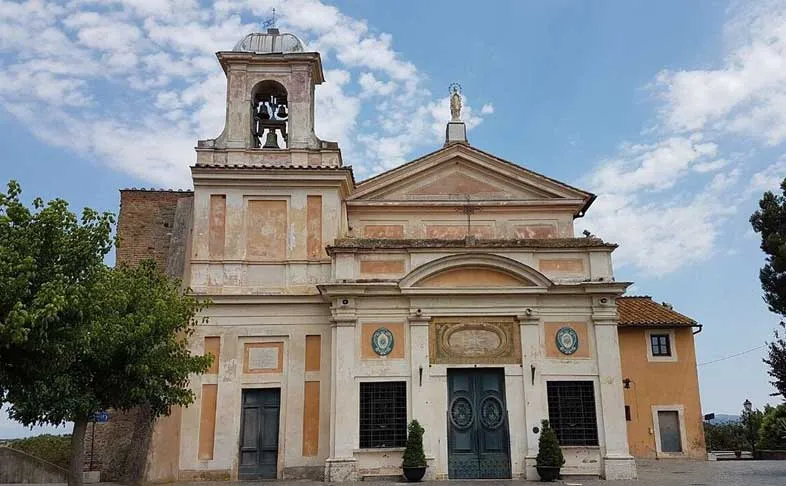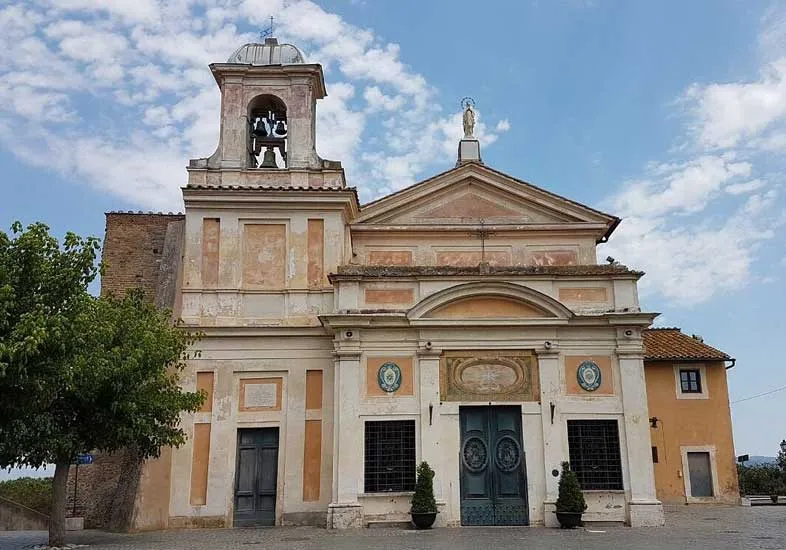
Introduction
Santuario della Madonna del Divino Amore, or the Sanctuary of Our Lady of Divine Love, is a Roman Catholic shrine in the southern outskirts of Rome dedicated to the Blessed Virgin Mary that consists of two churches: an old church built in 1745 and a new church added to the sanctuary in 1999. The church was included by Pope John Paul II in the pilgrimage of Seven Pilgrim Churches of Rome during the Holy Year 2000.
The sanctuary is the seat of the parish of Santa Maria del Divino Amore in Castel di Leva, erected by virtue of the apostolic letter of Pope Pius X Quamdiu for Roman agri of May 24, 1912, with the decree of the cardinal vicar Francesco Marchetti Selvaggiani Cum Summus Pontifex of December 1, 1932. Since 28 November 2020 the church has been the deaconry of Santa Maria del Divino Amore in Castel di Leva.
The most beautiful and moving place that can be admired while visiting the Sanctuary of the Madonna del Divino Amore is the ex voto room, which is like a room dedicated to the “unexpected”. There are thousands of ex votos. So much so that the Sanctuary struggles to contain them all. Many are a sign of gratitude to the Madonna for a “grace received”, others a simple invocation for help and protection. They express the history and faith of a people, but even more they speak of the power and unpredictability of the Christian God.
A God who chooses whoever he wants, who works as he wants and where he wants, as if to make fun of the presumptuous and ridiculous projects of men. “Here people come to us, while in the parishes they have to go and look for it”, often repeated Don Umberto Terenzi, the first parish priest of Divino Amore,
“The new Shrine of Rome”, as John Paul II defined the Divine Love. For those unfamiliar with Christianity it may seem like a paradox: in a city with a thousand churches rich in history and art; in a city, above all, which bases its faith on the blood of holy martyrs, the Almighty wanted to give a new sign of his mercy in this poor, lost and isolated corner of the Roman countryside. But the Holy Spirit, who is Divine Love, does not follow human logic.
The history of the Sanctuary of Divino Amore is deeply linked to these extraordinary signs which are miracles. From the first miracle, which took place in 1740, which saved the life of a pilgrim, to the one, in 1944, which spared the capital from destruction during the world war. And again, from the extraordinary figure of Don Umberto Terenzi – a “miracle” himself – to the many supernatural “signs” kept, for the most part, in the secret of the hearts of pilgrims, whose sentiment is expressed in the simplicity of an ancient popular song written in a language halfway between Italian and Roman dialect: “The Madonna of Divine Love gives thanks at all hours. We’re going to visit her”.
Miracles, as we well know, are not everything in the Christian faith. On their own, indeed, they are not sufficient to give eternal salvation, which is instead obtained with sanctifying grace, that is, with participation in the life of the Church. Miracles, however, are a powerful way in which God draws attention, sensibly imposing his presence. The miracle is an exceptional event, through which God shakes man, almost forces him to look after himself, the values he wants to make him share. So that, in the company of St. Augustine, we can say in our hands we have the Holy Scriptures, in our eyes the facts.
This is the experience of the thousands of pilgrims who have offered their sufferings, not only material ones, to Our Lady of Divine Love every day for over 250 years.
“May, our Mother that no one ever passes by this Shrine without receiving in their hearts the comforting certainty of Divine Love. Amen”: these are the words that Pope John Paul II, Bishop of Rome, pronounced on Sunday 4 July 1999 before of the recitation of the Angelus, at the end of the Dedication of the New Shrine of Our Lady of Divine Love.
History of Sanctuary of Our Lady of Divine Love, Rome

In 1295 the property belonged to the Savelli-Orsini family, who built a castle surrounded by a boundary wall and protected by six or eight towers. The property changed hands several times and by the early eighteenth century the estate had fallen into ruin. One of the towers of a gatehouse, known as the Castel di Leva, was decorated with a medieval fresco, a votive image of the Madonna and Child. The painting, whose artist is unknown, portrayed the Virgin Mary sitting on a Throne and holding the child Jesus in her arms. A dove descends upon her as a symbol of the Holy Spirit.
Local shepherds who grazed their flocks nearby during the winter would often meet here to pray the Rosary. In 1740, a pilgrim was attacked by angry dogs near the gatehouse and, according to the tradition, was saved through the intercession of the Blessed Virgin Mary. Seeing the image, the man invoked the Mother of God for help. Immediately, the dogs calmed down and ran off into the countryside. Word spread of this occurrence, and the following September the painting was moved to a nearby estate called “La Falconiana”, where a small church dedicated to the Virgin under the title Santa Maria ad Magos (St Mary of the Magi) stood.
On Easter Monday, April 19, 1745, the painting was returned to a new church, built near the site of the old tower. On 31 May 1750, Cardinal Carlo Rezzonico (later Pope Clement XIII) consecrated the altar in the church to Our Lady of Divine Love.
The church became a site of pilgrimage. With the increase of devotion from the people in the countryside, the church was entrusted to a hermit guardian, the first of which was Pasquale Francesco. After the fall of the Papal State in 1870 and the confiscation of church property, the property again falls into a period of neglect and decay, although the devotion of the faithful to Our Lady of Divine Love continues. Saint Mary of Love Divine is a devotional title in the Catholic Church for Mary, the mother of Jesus.
The image received canonical coronation on 13 May 1883 and can now be used by the faithful when addressing Mary for intercessions under this title. In December 1932, a parish was established and Don Umberto Terenzi appointed rector and the first parish priest. In March 1942 he founded the Congregation of the Daughters of Our Lady of Divine Love.
During World War II, the fresco was moved to the church of St. Ignatius. Pope Pius XII and many Romans visited the shrine to pray for the Holy Mother’s intercession that the city be spared. On June 11, 1944 Pius XII went to pray before the Image of the Virgin, surrounded by an immense crowd, and bestows the title of Salvatrice dell’Urbe.
In 1962, the Oblate Priests were founded, who since then serve the shrine. The pilgrimages increase, especially from Whit Monday until autumn. The shrine presently on the site is new, and was inaugurated by Pope John Paul II on July 4, 1999. Pope John Paul II included the shrine in the Seven Pilgrim Churches of Rome and the pilgrim itinerary for the Holy Year 2000, replacing San Sebastiano fuori le Mura.
Behind the chapel is a staircase that leads down to the gate tower where the miracle occurred in 1740. Pope Francis visited the shrine on 1 May 2018 to say the rosary, marking the start of the month dedicated to Mary.
On March 11, 2020, during the quarantine of Italy as a result of the novel Coronavirus pandemic, Pope Francis prayed before the image of Our Lady of Divine Love during a video broadcast, saying, in part, “We entrust ourselves to you, Health of the Sick, who at the cross took part in Jesus’ pain, keeping your faith firm. You, Salvation of the Roman People, know what we need, and we are sure you will provide so that, as in Cana of Galilee, we may return to joy and to feasting after this time of trial.”
Architecture
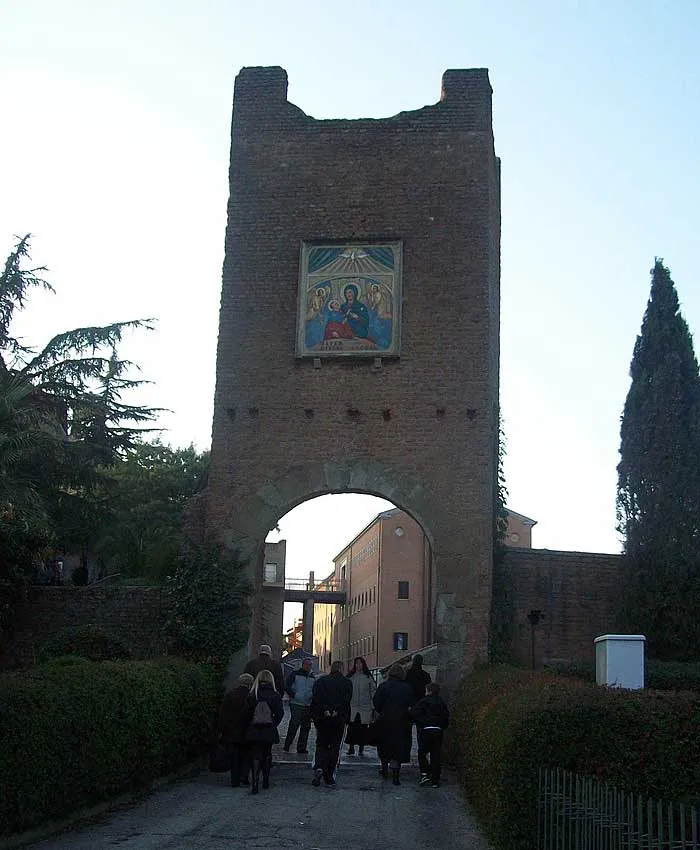
Burials : Luigi Beltrame Quattrocchi, Maria Corsini.
The miraculous painting is enshrined above the altar. The mosaics in the apse are modern, and shows Christ in the centre, and the miracle on the left.
In the crypt is the tomb of the married couple Bl. Luigi (Aloysius) Beltrame Quattrocchi and Bl. Maria Corsini Beltrame Quattrocchi. He died in 1951, and she in 1965. After their deaths, a beatification process was started. They were beatified on 21 October 2001 by Pope John Paul II, and this was the first time that a married couple had been beatified together. Their relics were moved here on 28 October 2001. The feast of Bl. Luigi and Maria Corsini Beltrame Quattrocchi is celebrated on 25 November, their wedding day.
Our Lady of Divine Love
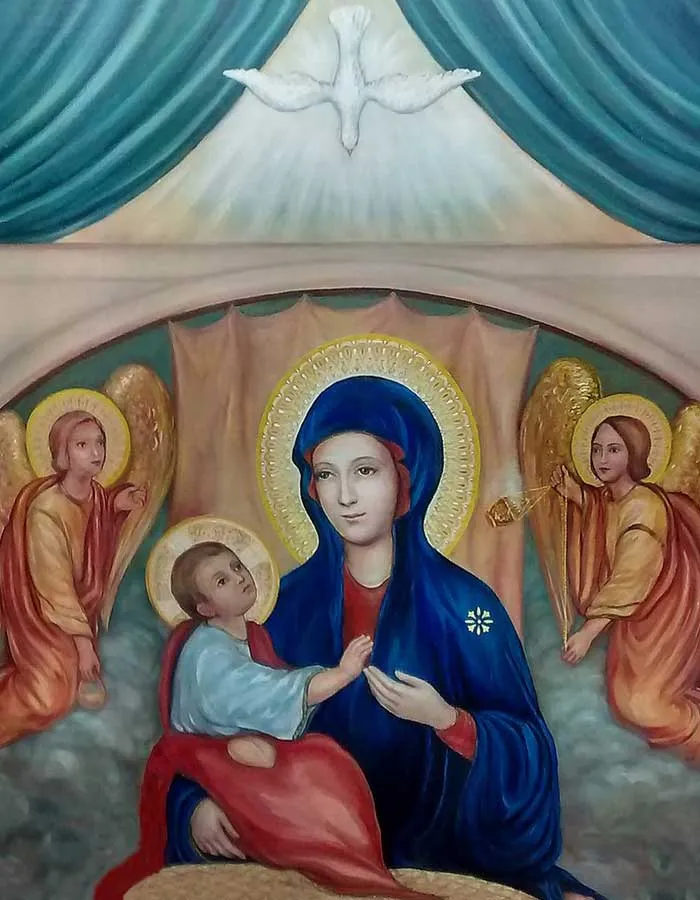
The Appian Way leading from Rome southward as far as Brindisi was built by Claudius Appius in 312 b.c. This road, more than two thousand years old, is still in use though a Via Appia Nuova, a new Appian Way was built between the two world wars, to facilitate the increasing traffic around the Eternal City. The existence of the new Appian Way did not alter the importance of the old one. Here the Roman legions, barbarian armies and Christian martyrs marched.
Leaving Rome on the Via Appia Antica, we have before us the Campagna and the hills of Frascati, Albano, and Castel Gandolfo, which are called the “Castelli Romani.” Between the hills and walls of Rome lies that part of the Via Appia, which was the scene of much of Rome’s spiritual and secular history. This road, lined with tall pines, was a favorite burial place of rich families of ancient Rome. Many monuments of the dead are still there and even in their silence speak of the presence of pagan Rome in the center of Christianity. Beneath the earth, there are other monuments of even greater importance: the catacombs.
Thus, Rome’s present and Rome’s manifold past give the particular setting to one of the most cherished shrines of Mary in the Eternal City. The sanctuary of the Madonna of Divine Love is situated on the Via Ardeatina, in the region of the Via Appia and the Catacombs. La Madonna del Divino Amore is known to all pilgrims to Rome, but it is particularly dear to the hearts of the Romans and especially to those living in the outskirts of the city. This shrine’s popularity is surpassed only by that of the shrine dedicated to the protectress of Rome, the Salus Populi Romani in the Basilica St. Maria Maggiore. The sanctuary of the Madonna of the Divine Love was built in the middle of the eighteenth century; the image dates back to the early fourteenth century.
During World War II, when Rome was constantly in danger of becoming a center of actual fighting, the population journeyed daily by the tens of thousands in spontaneous pilgrimages to this lovely shrine, asking relief from the overpowering uncertainty and tension. The climax of the crisis approached when the Allies landed at Anzio. At the insistent request of the population, the clergy removed the mural from the shrine on the Via Ardeatina, which was then about thirteen miles from the front.
The image was set up in the Church of St. Ignatius within the city of Rome. At that time the Holy Father placed Rome under the special protection of the Madonna of Divine Love. After the liberation, Pius XII immediately went to the Church of St. Ignatius and, in a most moving ceremony, declared her the Saviour of Rome. After the war the image was returned to its original sanctuary.
The First Miracle
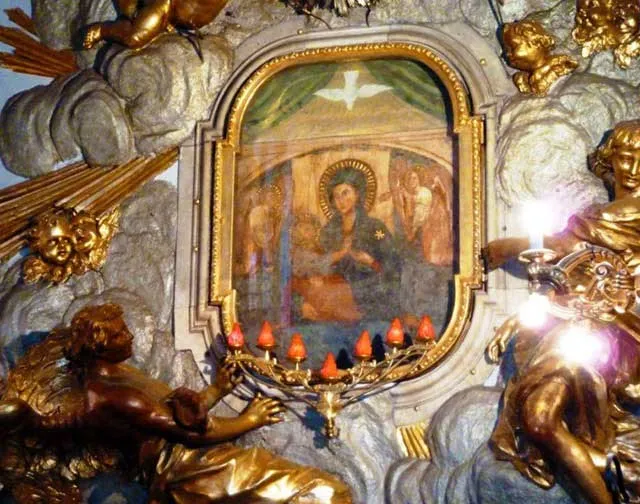
According to legend, in the spring of 1740 a pilgrim on his way to St. Peter’s basilica got lost in the inhospitable and unhealthy countryside near Castel di Leva, about 12 km south of Rome. Sighting some farmhouses and a ruined castle on top of a hill, the traveler heads there hoping to find someone who can give him information to find the right road. However, he is attacked by a pack of rabid dogs that surround him. The pilgrim, looking up, realizes that on the tower of the castle there is an icon depicting the Virgin and Child, dominated by the dove of the Holy Spirit.
He therefore invokes the Madonna save him from that danger. The beasts that are on him suddenly stop and disappear. The shepherds who are in the area, recalled by the wayfarer’s screams, rush to the place and, having heard his story, put him back on the road to Rome. The pilgrim’s name is unknown but the news of what happened soon spread throughout the city, so much so that the icon of the Madonna in Castel di Leva soon became a pilgrimage destination.
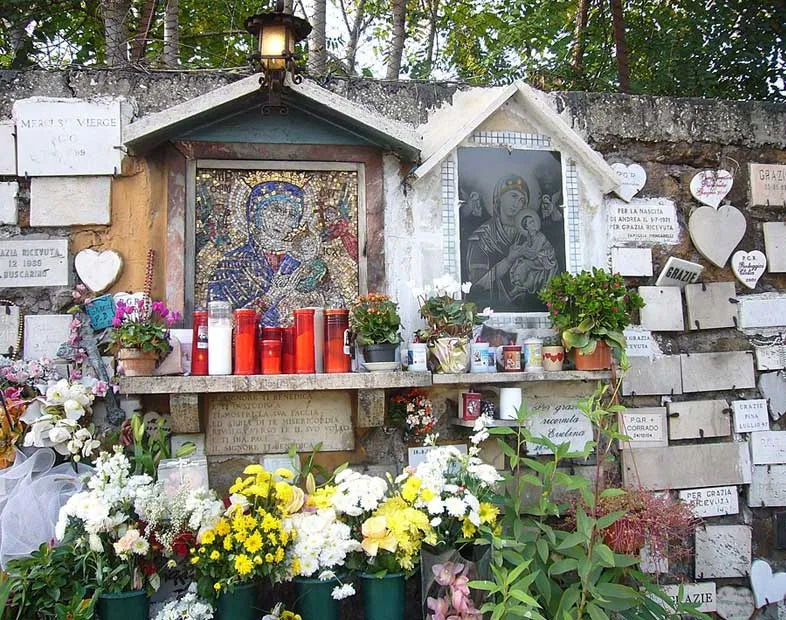
The Sanctuary
On 5 September 1740 the icon was removed from the tower and taken to the nearby estate called “La Falconara”, where the small church of Santa Maria ad Magos is located.
On April 19, 1745, Easter Monday, the icon was moved to a place near the tower, which still stands today, where in the meantime a new church has been built the work of an unknown architect. The fresco is enthroned in the main altar, where it is currently located. The participation of the people who came from Rome and the nearby Castelli is such that Pope Benedict XIV decides to grant plenary indulgence not only for the day of the transfer but also for the following seven days.
The custody of the new sanctuary is initially problematic given its position in an isolated place, easy prey for bandits and brigands: dozens of religious orders were consulted, but no one felt like facing such a task.
The new sanctuary was first entrusted to a hermit custodian, then, in 1805, to priests who lived there only during the Pentecost period, when pilgrimages were more numerous. In 1840, the centenary year of the first miracle, the church and the altar were restored, the stuccos gilded again, two other altars and numerous confessionals were installed.
Drapes, damasks and other sacred furnishings were brought from Rome. Even the via Ardeatina, which leads to the sanctuary, reduced to a very bad state, was rearranged. The celebrations, also attended by King Michael of Portugal, begin on 7 June 1840, Pentecost Sunday, and end 7 days later.
After the celebrations for the centenary, a season of decline begins: around the Sanctuary, especially in the days close to Pentecost, stalls of porchetta, pecorino, broad beans and wine are set up accompanied by the phenomenon of the “madonnare” or Roman mostly greengrocers and laundresses, who celebrated their particular annual feast on Pentecost Monday.
This mixture of sacred and profane led to a progressive decline of the sanctuary in the first decades of the twentieth century which almost fell into oblivion. In 1930, when the sanctuary became dependent on the vicariate, a rector was sent to the site, with the obligation of residence, who from 1932 also became pastor of the parish of Divino Amore. The first rector of the sanctuary was the young priest Don Umberto Terenzi, who had survived a road accident right near the sanctuary.

June 4, 1944 : A Vote For The Salvation Of Rome
The events of the Second World War also involve Our Lady of Divine Love. After the area of the Sanctuary had been bombed the day after 8 September 1943, the icon of the Madonna was brought to Rome on 24 January 1944. Triumphantly received in the city by the people, the image is first taken to the little church of the Madonna del Divino Amore, which is located near Piazza Fontanella Borghese, and precisely in vicolo del Divino Amore, but in May, given the enormous influx of faithful , is transferred to San Lorenzo in Lucina.
Pope Pius XII, given the imminence of the battle for the conquest of Rome between the Nazis and the Allies, solemnly invites the Romans to pray for the salvation of the city during the Octave of Pentecost and the novena of Our Lady of Divine Love, begin that year on May 28, 1944. The turnout in San Lorenzo in Lucina in those days increases so much that one is forced to transfer the image of the Madonna to the larger Sant’Ignazio di Loyola in Campo Marzio. On June 4, the same day on which the octave ends, the fate of Rome is decided.
At 6 pm, in the crowded church of Sant’Ignazio, the text of the vow of the Romans to Our Lady of Divine Love is read so that the city may be spared from the destruction of the war. The faithful promise to correct their moral conduct, to erect a new sanctuary and to carry out a work of charity in Castel di Leva. The vote was cast in great haste, due to the curfew which would have started at 7pm.
Instead of the Pope (who was unable to leave the Vatican due to the danger of deportation), the camerlengo of the parish priests, Father Gremigni, read the vote. That same evening the Germans leave Rome and the Allied troops make their triumphal entry into the city. On 11 June, as thousands of Romans had done for over four months, Pope Pius XII was able to go to the church of Sant’Savior of the city.
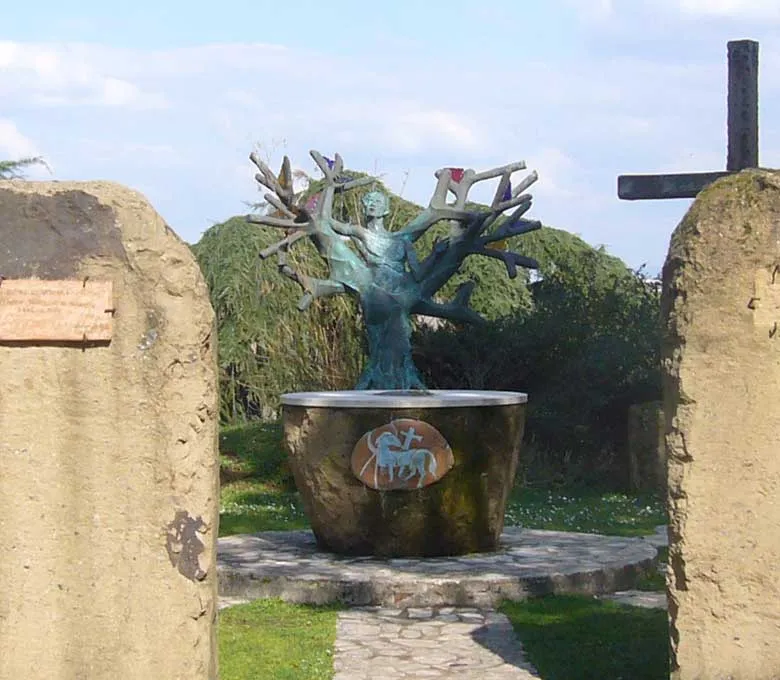
The Fulfillment Of The Vow
After the war, under the impulse of the rector Don Umberto Terenzi, the sanctuary in Castel di Leva was reborn: the seminary of the oblates of Divine Love was born (who have since then guarded and animated the sanctuary), the Congregation of the daughters of the Madonna del Divino Amore (still today engaged in the service of the charitable works born around the sanctuary such as the nursery school, reception and assistance for minors in difficulty).
Don Terenzi attempted to provide for the construction of a new sanctuary to fulfill the vow made at the end of the war, but bureaucratic difficulties and logistical difficulties always prevented him from carrying out this work.
We will have to wait until 8 January 1996 for the cardinal vicar Camillo Ruini to lay the first stone of what, for the Jubilee of 2000 , has become the new sanctuary. The structure, capable of accommodating over 1500 pilgrims, was built at the foot of the hill, outside the ancient walls, without violating the landscape of the Roman countryside and the eighteenth-century monumental complex. The new sanctuary was designed by the Franciscan friar and priest Father Costantino Ruggeri (1925-2007), painter, sculptor, glassmaker, “bâtisseur d’églises”.
Devotion - Nocturnal Pilgrimage
The sanctuary of Divine Love is a pilgrimage destination very dear to the Romans: every Saturday, from the first after Easter to the last of October, a night pilgrimage on foot is held, starting at midnight from Piazza di Porta Capena, near the Circus Maximus . At dawn, after traveling 14 km, you reach the sanctuary where the pilgrim’s mass is celebrated.
News Agents
The devotion of the Roman people to this Madonna is also manifested in numerous newsstands scattered throughout the city; for some of these, over the years, popular piety has covered the surrounding walls with densely packed tiny tombstones “for grace received”.
A very large number of these ex votos, for example, were attached to the Aurelian walls near the Polyclinic; after the 1970s they were disassembled and transferred and partly reassembled on the outer wall of the sanctuary.
Feast Day - 12th September
Annual Feast Day of Our Lady of Divine Love held on 12th September.
Mass Time
Weekdays
Saturdays
Sundays
Church Visiting Time
Contact Info
Via del Santuario 12, Rome, Italy
Phone No.
Tel : +39 06 713 518
Accommodations
How to reach the Sanctuary
Leonardo da Vinci – Fiumicino International Airport in Italy is the nearby Airport to the Sanctuary.
Torricola Train Station in Rome, Italy is the nearby Train Station to the Sanctuary.

